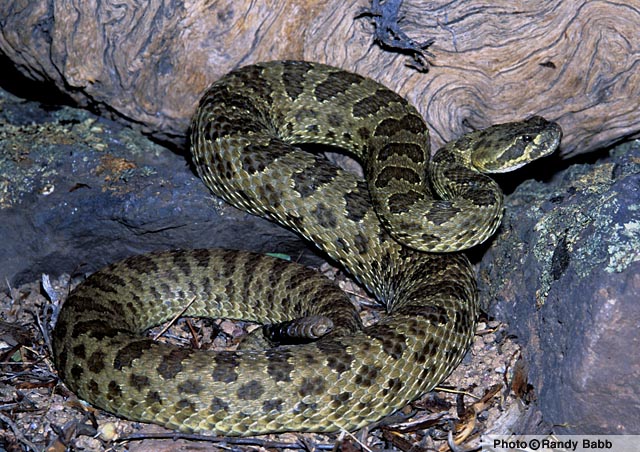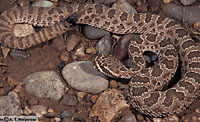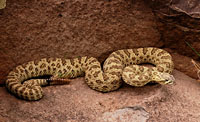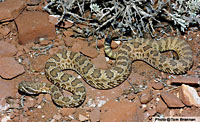Online Field Guide to The Reptiles and Amphibians of Arizona



Apache County, AZ
 Apache Co., AZ |
| PRAIRIE RATTLESNAKE Crotalus viridis |
Venomous
|
| DESCRIPTION: Maximum size for this rattlesnake ranges from 700 mm (28″) to 1,620 mm (64″) in total length excluding rattle. Base coloration is highly variable. Individuals can be olive, straw-yellow, gray-brown, pinkish, or orange-brown. A series of large, dark blotches, often with thin white edges, runs the length of the back. Two additional rows of small blotches line each side. Facial and head markings are usually prominent and include dark bars extending from the eye to the corner of the mouth. A dark bar often extends across the top of the head between the eyes. The pupils are vertically elliptical. The dorsal scales are keeled. The neck is slender and the head is broad and triangular. On the end of the tail is a rattle composed of a series of loosely interlocking keratinous sections. A new section is added each time the snake sheds its skin.
DISTRIBUTION: This snake is distributed across the plateaus of northeastern Arizona south and east of the Colorado River. In Arizona it is found at elevations ranging from ca. 4,500′ to about 9,000′. HABITAT: The Prairie Rattlesnake is found in Great Basin Desertscrub, Plains and Great Basin Grassland, and lower reaches of Great Basin Conifer Woodland communities. It is often encountered near features such as rock outcroppings and low ridges but it is also encountered on vast, relatively featureless plains. DIET: The Prairie Rattlesnake feeds on mice, other small mammals, birds, and lizards. It uses venom injected through long, hollow, retractable fangs to kill and begin digesting its prey. REPRODUCTION: Mating takes place in July and August. Young are born in summer. GREEN PRAIRIE RATTLESNAKE Crotalus viridis viridis. This subspecies is larger (up to 64″) and is usually tan or yellow-brown with brown blotches. Some specimens are olive or greenish-gray. REMARKS: This rattlesnake is capable of delivering large amounts of potent venom. If encountered it should be left alone. A large percentage of envenomations occur when a snake is handled or abused. By Thomas C. Brennan Bartlett. 2000. Snakes of North America: Western Region. Gulf Publishing Co. Houston, TX Brennan, T. C., and A. T. Holycross. 2006. A Field Guide to Amphibians and Reptiles in Arizona. Arizona Game and Fish Department. Phoenix, AZ Degenhardt, W. G., Painter, C. W., and Price, A. H.. 1996. Amphibians and Reptiles of New Mexico. University of New Mexico Press. Albuquerque. Fowlie. 1965. The Snakes of Arizona. Azul Quinta Press, Fallbrook, California Lowe, Schwalbe, Johnson. 1986. The Venomous Reptiles of Arizona. Nongame Branch Stebbins. 1985. Western Reptiles and Amphibians. Houghton Mifflin. New York, NY |
|
Visit Partners in Amphibian and Reptile Conservation:


HOME
Copyright © 2023, Arizona Game and Fish Department. All rights reserved.
If you make use of the textual contents of this site in reports, publications, etc. please cite and credit the author(s) and photographer(s). All photos on this website are copyrighted. However, those found in the species account section may be used for any noncommercial scientific, educational, or conservation purposes provided that photographs are not altered and continue to bear the copyright symbol and name of the photographer. Please contact the photographer regarding commercial use of copyrighted photographs.












